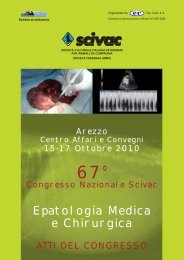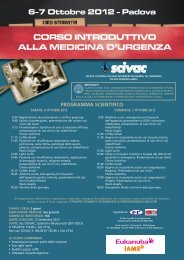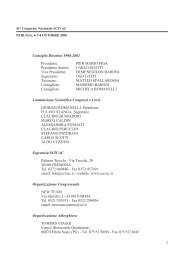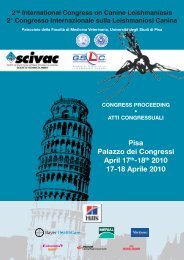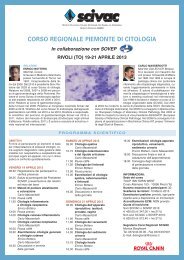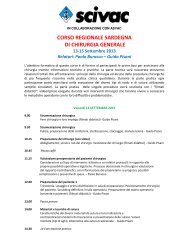58° Congresso Nazionale SCIVAC: Oncologia veterinaria
58° Congresso Nazionale SCIVAC: Oncologia veterinaria
58° Congresso Nazionale SCIVAC: Oncologia veterinaria
Create successful ePaper yourself
Turn your PDF publications into a flip-book with our unique Google optimized e-Paper software.
58° <strong>Congresso</strong> <strong>Nazionale</strong> <strong>SCIVAC</strong> • Milano, 7-9 Marzo 2008 • <strong>Oncologia</strong> <strong>veterinaria</strong> - Alle soglie del III Millennio<br />
nase-2 signaling as a direct growth stimulant to urothelial cells. In one study<br />
of 34 dogs treated with piroxicam, there were 2 complete remissions, 4 partial<br />
remissions, 18 with stable disease, and 10 with progressive disease. The<br />
median survival time was 181 days, however, the quality of life was improved<br />
in all of the dogs. Other non-steroidal COX-2 inhibitors may also be useful<br />
in transitional cell carcinoma. A recent report of firocoxib at a dose of 5<br />
mg/kg PO daily combined with 60 mg/m 2 IV cisplatin every three weeks<br />
showing promise in the dog, with a 50% response rate noted for 12 dogs receiving<br />
this therapy.<br />
A multicenter trial sponsored by the Veterinary Cooperative Oncology<br />
Group revealed that 48% of 55 dogs enrolled had measurable responses to a<br />
combination of mitoxantrone and piroxicam. Mitoxantrone was administered<br />
at 5 mg/m 2 every 21 days for 4 cycles, and piroxicam was administered at 0.3<br />
mg/kg/day throughout the trial period. Of 48 evaluable dogs at the end of<br />
study, only one dog had a complete response, while 16 had partial responses<br />
and 22 had disease stabilization. Gastrointestinal toxicity and azotemia were<br />
the most common adverse effects, seen in 18% and 10% of treated dogs, respectively.<br />
Median time to treatment failure was 194 days, and median survival<br />
time was 350 days, demonstrating the indolent nature of TCC even in the<br />
case of incomplete response.<br />
Intravesicular therapy with such agents as cisplatin, methotrexate, cyclophosphamide,<br />
and 5-fluorouracil have been effective in humans. This form of<br />
therapy is most effective against superficial tumors that are not invasive into<br />
the bladder wall. Some evidence suggests that intravesicular therapy may irradicate<br />
residual disease after incomplete resection. Unfortunately, most bladder<br />
tumors in dogs are invasive at the time of diagnosis. Intralesional BCG at<br />
the time of partial cystectomy showed variable results. Two of seven dogs<br />
treated intraoperatively with BCG showed clinical benefit, but two dogs developed<br />
severe granulomatous reactions with secondary obstruction. Recently,<br />
intravesicular therapy with mitomycin C has been attempted in dogs<br />
with evident safety, but studies are preliminary.<br />
Radiation Therapy - There are few reports on the effectiveness of radiation<br />
therapy use in the control of bladder tumors. In one study, intraoperative radiation<br />
therapy followed by fractionated external beam irradiation resulted in<br />
poor local control and serious bladder fibrosis with resultant incontinence.<br />
Fractionated external beam irradiation alone requires using traditional fractionation<br />
of 3-4 gy/radiation fraction has been attempted with poor long term<br />
results due to the cumulative doses of radiation needed for eradication of the<br />
cancer. Significant risk of serious bowel injury can be reduced by utilizing<br />
small dose-per-fraction therapy over an extended time period (2.7 Gy x 20<br />
fractions). Combination of radiation with mitoxantrone and prioxicam has<br />
been reported to improve clinical signs in 7/10 dogs so treated.<br />
93



